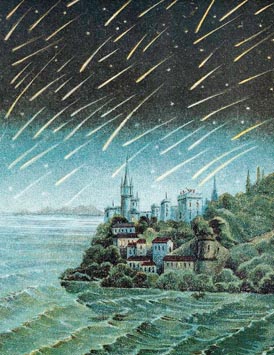
Meteor specialist Peter Brown (University of Western Ontario) reports that the Canadian Meteor Orbit Radar has recorded an outburst from the Andromedid meteors in the past 24 hours. Moreover, he reports, "It is not clear if the peak of the outburst has been reached or if activity may continue to increase."
You'd be forgiven if you've never heard of the Andromedids, let alone that they'd be worth watching. This is a stream of debris shed by the now-defunct periodic Comet Biela, which was discovered three times: in 1772, 1805, and 1826. In 1846 this curious interloper returned as two comets traveling side by side.
But Comet Biela is best remembered for the torrent of meteors it unleashed on November 27th in both 1872 and 1885, when thousands of meteors per hour flashed across the sky and Chinese observers noted that "stars fell like rain."
Over time the "Bield" meteors (later renamed Andromedids) dwindled to near nonexistence. But they returned in 2011 with a zenithal hourly rate of about 50, their strongest showing in more than 100 years. Radar records suggest that the strikingy bits are quite small and slow-moving, stiking Earth at 10 miles (16 km) per second - about the minimum speed possible.
Brown is encouraging amateurs to make visual observations if possible. The radiant is roughly at right ascension 0h 48m and declination +60° - about 10° north of the Andromeda galaxy near the bright star Schedar in the "M" of Cassiopeia. Brown adds, "It is possible to follow the activity in near real-time as detected by CMOR."
If it's cloudy tonight, as sadly it will be here in New England, you should still Check out Gary Kronk's comprehensive histories of Comet Biela and the Andromedids.



Reader Comments
to our Newsletter